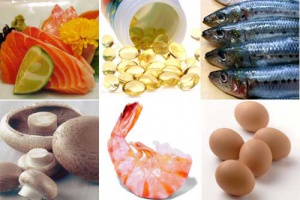Vitamin D
Contents
Description
A group of fat-soluble secosteroids known as the “sunshine vitamin”, vitamin D is available in two major forms: vitamin D2 AKA Ergocalciferol and vitamin D3 AKA Cholecalciferol. Vitamin D, if not referred to otherwise, is in the form or either vitamin D2, D3 or both forms. Vitamin D3 is created in the skin of vertebrates after exposure to UVB light from the sun and is also available in foods or in supplemental form.
Health Benefits
There are various health benefits offered with vitamin D including to but not limited to boosting the immune system, fight off viral infections, limit inflammation in the body, strengthens bones, protects against various forms of cancer, prevents and treats both Type I & II Diabetes, hypertension, glucose intolerance, multiple sclerosis, various autoimmune diseases, schizophrenia, and other medical conditions. Vitamin D supplements provide various benefits in people with tuberculosis. The vitamin may also help prolong life, assist with breathing ability in asthma sufferers and helps form and maintain bones.
Beauty Benefits
There are many beauty benefits associated with consuming vitamin D such as the treatment of psoriasis, plays a large role in skin cell metabolism and maintenance, treatment of itchy, flaky skin, acts as a powerful antioxidant which protects against free radical damage, prevents premature aging and damage to skin, and has been shown to help reduce dark circles around the eyes.
Food Sources
Vitamin D exists naturally in human absorption of the sunlight, but is also available in a variety of food sources including but not limited to:
- Catfish
- Salmon
- Mackerel
- Sardines
- Tuna
- Eel
- Fortified Milk
- Eggs
- Shrimp
- Cod Liver Oil
- Mushrooms
Daily Dose Recommendations
- Infants & Children: Up to 13 Years 5 Mcg/ Day, 14-18 Years 5 Mcg/Day
- Adults: 19-50 Years 5 Mcg/Day, 51-70 Years 10 Mcg/Day, 71+ Years 15 Mcg/Day
Side Effects
Toxicity of vitamin D can occur from over intake of vitamin D2 which is available from plants or vitamin D3 which is available from animal sources. Symptoms include nausea, vomiting, high blood pressure, loss of appetite, kidney malfunction, depression, and illness.
Deficiency
The most common deficiency is caused by lack of exposure to sunlight and can be remedied by increasing your time in the sun, ingesting foods with vitamin D or taking a vitamin D supplement.
Related Discussions
- Vitamin D - A Fatal Underdose?
- Mushrooms, Vitamin D and More Food Facts
- Best way to get vitamin D.. is D3 really better?
- Vitamin D supplements lack D
- Mushrooms, Vitamin D and More Food Facts
- Low in Vit D
- Vitamin D Theory of Autism
- Vitamin D
